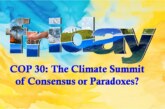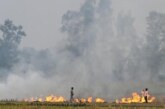
By Kavita Prasad | Senior Consultant |India Water Foundation |

This article draws upon the impact of climate change on the globe especially on women’s health and the need for strengthening the policy structure.
Introduction
Climate change is altering the capacity of ecosystems. The fundamental transformation of weather events, biodiversity and food webs are likely to mitigate disturbance in global communities. The impacts will vary by geographic conditions, territorial exposure, context distinct social groups, identity, power distribution and political economy.
Scientific studies are progressing to understand and downscaled projections to accurate eco-feminine aspects whereas, climate mitigation is being researched and adopted by the international community, State governments, civil societies and local non-government communities, but gender difference dimensions have been diminutive in policy decisions. Different subjects of law support justice for Mankind and the environment due to the change in climatic conditions. The International policy and legal responses to State and individuals raise issues for climate change and consider the responsibility of States into account to strengthen state policy through various declaration, conventions, agreements, treaties and action programmes.
Impacts of climate change on the Globe
According to WHO, “Health of an individual, is the state of physical, mental and social well-being”[1]. Considering the biomedical model of health, the integrity of anatomic, physiological and psychological factors are incomplete without ecological impacts on the globe.
Although climate change directly affects Earth’s temperature and equilibrium due to global warming, energy balance, greenhouse gas emission, atmospheric composition ratio and biodiversity threats, the scientists suggest major pointers or tipping points of individual subsystems and a global climate. They can calculate the direct proportionate ratio of a global rise in temperature, with the climate system. The higher the temperature, the maximum climate system is affected. The worst part of this disturbance is that it is irreversible, we can support the Nature in healing by limiting human interference but reversing the Natural damage is beyond our calibre. These tipping points can be considered as a global alarm for biodiversity threats and mankind disruption. Such potential tipping points helps to identify the climate emergency in line with impacted ecosystems.
The attributes of man-made climate change include:
- rising maximum and minimum temperatures
- rising the sea levels and distance from the sea
- higher ocean temperatures and current
- disturbed ocean pH
- disturbed air masses
- disturbed direction of prevailing winds
- heavy precipitation of rainfall and hail
- reducing glaciers
- land distance from the equator
- change in latitude
- increase in thawing permafrost
- the El Niño phenomenon and its effects
Impacts of climate change on Mankind
The indirect threats of climate change, are the indicators of direct loss to human security and our environment, which cause a moderating effect. Furthermore, the essential 5Fs are the pillars of human survival, which is defined by IPCC[2]: Food, Fibre, Feed, Fuel and Freshwater.
The primary damage of Mankind is the increasing need for hunger and water crises across the globe, especially in developing countries are due to disturbed biographic regions, air temperatures and heat waves. It leads to major health risks through biodiversity loss like the increasing spread of pests and pathogens, the effect on flora and fauna, ocean acidification due to increased HCO3 and CO₂ concentrations in the water as well as in the air respectively.
The secondary damage is, the imbalance in socioeconomic consequences arise due to loss in agriculture, forestry, energy, infrastructure, livelihood and tourism. Whereas the tertiary damage is the damage to human health. It is indirect but most scary damage, as it is slow (1850 till now) but deep-rooted and most difficult to encounter for the health system. As the global ecosystem is a highly interconnected system, it is influenced by different factors like the consequences of climate change on ecosystem usually result in positive or negative feedback effects. This refers to sustainable developments that are motivated due to the occurrence of natural-manmade factors.
Impacts of Climate Change on Health system
As provided some background context, the major reason of human health impacts due to climate change includes increased temperature, polluted and disproportionate air quality, disturbed marine ecosystem, extreme weather events, unexpected climate conditions, the biological transmission of vector-borne disease, poor water quality, and alarming food quality.
The disturbed ecosystem affects biodiversity and this change affects natural science directly. Referring to the life sciences, men and women differently react towards change in climatic conditions, depending on their geographic and socioeconomic factors. The threat of gender-based health disparities is comparatively more in developing and under-developing countries. The gendered health is the impact, which accelerates and mediate among geographic, socioeconomic, cultural, physiological, psychological and genetic evolution factors.
Women’s health in Climate Change Nexus: reasons and impacts
The genetic, biological and psychological nature of women, allows society to associate the female gender closer, which coexists as Mother Nature. The sanctity and harm of environment affect women directly as they are physically sensitive and socially weak, they have to pay the price for being closer to nature instead of getting benefit from it. This instrumental role of climate nexus degrades the intimate ecofeminism association by impacting unintentional and indirect interventions like hampering climate change.
Reason: Poor air quality and disturbed gaseous ratios with elevated temperature.
Impact: It leads to women’ respiratory and cardiovascular diseases as they experience a high deposition rate of pollutants in their lungs. Also, the higher prevalence of anaemia makes them more sensitive to toxic exposure[3]. Considering the rural cases especially in South Asia, the primary role of a woman is to cook food using conventional stoves. It produces carbon monoxide, hydrocarbons and particulate matter which accounts for 25% of the air pollutants. As global social structure encourage them to spend more time at home, thus they are disproportionately affected with Climate change nexus (CCN).
Reason: Adverse reproductive outcomes like stillbirth, intrauterine growth restriction and congenital defects are few indirect impacts of climate change.
Impact: As major air pollutants like Carbon dioxide can cross through the placenta linings, it can affect foetal growth during pregnancy. The social and political system do not strive to provide attention towards comprehensive maternal respiratory and cardiovascular health, but it can lead to major problems in foetal development, neonatal growth and placental functions.
Reason: Increased rate of climatic hazards (natural/man-made/accidental) like floods, hurricanes, wildfires and droughts.
Impact: In the present socio-economic structure women face unequal access to basic amenities, especially women with lower socioeconomic status, poor, single, elderly women, adolescent girls and women with disabilities. They have to face higher risk factors like abuse or we can say all types of abuse like social, physical and psychological including sexual violence. Furthermore, such women face mental disorders like depression, stress, anxiety and post-disaster trauma. The poor baseline dietary/nutritional deficiencies and physical limitations may affect their escape and survival during post-disaster. The pregnant and giving birth women face a higher risk of complications like excessive bleeding, placentapsia and low birth rate weight of infants. Poor access to obstetric care during and post-disaster is the worst impact of climate change on women health.
Reason: Exposure to shifting rainfall, temperature pattern in pair crops, livestock, optimum fishery yields or food insecurity.
Impact: In developing and underdeveloped countries women produce 60-80% of the state livelihood products. Hence, climate change directly impacts agricultural structure. Nutritional scarcity can be described by various socio-cultural practices. As women are inherently sensitive to the effects of food instruments of the family besides with nutritional needs during menstruation, pregnancy and lactation period. According to the several health surveys, most of the micro nutritional deficiencies arise due to anaemia, which is the cause of cognitive impairments, like poor focus span, weak memory, emotional regularity issues and impaired sensory perception. The malnutrition negatively impacts neonatal growth due to intrauterine linings and its development including perinatal morality.
Reason: Water Insecurity.
Impact: Shifting rainfall, disturbed air velocity/humidity/temperature/ evaporation rates and air space cause water insecurity to the entire ecosystem. Culturally women are responsible to meet the family needs; fulfil hunger and water requirements for the family. In some parts of the globe, women travel a long distance to collect water from natural resources. In search of water and livelihood activities like harvesting, consumes 85% of common female time and energy in rural areas. The need for water security force women to expose more towards vector-borne diseases or biologically contaminated water, whereas, the bacterial viral and protozoan infection exposer is more common among women. On the contrary, the lack of water accessibility and sanitation leads to unsafe health conditions, especially during the reproductive phase. The poor maternal and neonatal outcomes, different types of infections, hormonal changes in immunologic functions during pregnancy can lead to higher viremia and parasitemia infections. Also, anaemia, diminishes transplacental nutrients transport again reflects the increased vulnerability of the mother to haemorrhagic complications of delivery[4]. The viruses like dengue and zika, carry devastating foetal impacts including CNS malformations, impaired cognitive development and microcephaly i.e. children can face major disorders like delayed motor functions and speech, facial distortions, dwarfism or short stature, hyperactivity, seizures, difficulties with coordination and balance, and other neurological issues. Studies say that the risk of malaria is more in women, in fact, three times more in pregnant women than a common person. The change in biodiversity is altering the food chain distribution of vector-borne disease.
Reason: Human migration and mitigation due to climate change are the reason for enforced “trapped” population.
Impact: The natural hazards are not the only reason for human migration but also the socio-economic migration drives human population especially women to migrate. A tradition like marriage, lack and /or less education, low employment ratio can be considered as the major pushing factors in a women’s life cycle. The forced migration due to environmental disasters is physiological pressure on women’s health.Poor sanitation and lack of health services for refugees and migrants are the common issues to be addressed and mitigated. Women with a partner in the travelling profile, are more exposed to STD infection including HIV. Migration with lack of basic amenities can place women at risk of human trafficking, sexual abuse and domestic violence[5].The urbane studies concerning the psychiatric disorders anxiety and depression are more prevalent among urban women than men and, are believed to be significantly associated with more hostile, negative parenting, and with more disengaged (withdrawn) parenting[6].
The wrath, pain, grief, or trauma are not the personal reflection of women’s life. The root cause of all the social health problems needs to be addressed through climate change nexus.

Furthermore, the health analysis of women is affected by state provinces, disaster management policies and their enforcement, human right and local judiciary system.
The Rule of law and Climate justice
The immense human consequences and` relation with climate change has been discussed in this article. Furthermore, the Environmental Protection Act (EPA)has been created in the light of International law to enforce the International environmental law and to implement the decisions of the United Nations Conference (1986) among all the legal and social instruments. The aim of all the socio-legal instruments like International conventions, declarations agreements and treaties are more effective by state policy enforcement acts. The International law, State’s jurisdiction and policy outline to establish female power. It can be used to catalyse the environmental management[7].
The acts of civil disobedience to raise awareness around pollution of water resources, nuclear waste, and creating protected nature reserves will be easier if coordinated by women. The States has to protect the violation of international human rights treaties, which prohibits discrimination based on gender in all areas, from livelihood opportunities and rights on the property, violence free atmosphere (house, workplace and public places), to equal access to the education and participation in government and above all right for good health.
The International environmental policy covers several issues and supports major International agreement and treaties on environmental protection[8] like:
- Vienna Convention for the Protection of the Ozone Layer (1985)
- UNFCCC Framework Convention on Climate Change (1992)
- Kyoto Protocol (1997)
- Paris Agreement (2015)
- The Montreal Protocol (signed by 197 countries) – the first treaty in the history of the United Nations to achieve universal ratification – and is considered by many the most successful environmental global action.
- Convention on International Trade in Endangered Species of Wild Flora and Fauna (CITES) Parties: (183 members)
- Convention on Biological Diversity (CBD) Parties: (196 members)
- The Montreal Protocol on Substances That Deplete the Ozone Layer.
Climate justice in the framework of feminine interlinkages
Climate justice cannot be separated from the fight for social justice and society cannot be created without feminine intervention. The feminine perspective aims to provide a vision, on how the rule of law can be useful to the States to frame women centric environment action plan and policies. The secluded presence of women in sustainable development has been discussed in the International Conference on Population and Development (1994), the Beijing Declaration and Platform for Action (1995), the World Summit on Sustainable Development (2002), and the 2005 World Summit. The Convention to Combat Desertification (2008 with 193 State Parties) acknowledged the women’s participation in decision-making policies and programmes to support action plan for desertification and drought. Also, the 1979 Convention on the Elimination of All Forms of Discrimination against Women (CEDAW) states that “Parties shall take all appropriate measures to eliminate discrimination against women in the political and public life[9]”, and to ensure that women are at the same page with men in both governmental and non-governmental organizations to support implementation plans to catalyse development and implementation of the policy.
Also, the CEDAW Committee issued a statement on Gender and Climate Change in 2009, escalating the voice in absence of a gender perspective in the United Nations Framework Convention on Climate Change (UNFCCC) and other global and national policies and initiatives on climate change. The committee called States Parties to include gender equality as an overarching guiding principle in the UNFCCC agreement expected at the 15th Conference of Parties in Copenhagen[10]. The action plans have been called to mainstream a gender perspective in 2002, the Commission on the Status of Women considered the issue of climate change at its 46th session. All the State Parties agreed to include and encourage women participation into ongoing research on the impacts and causes of climate change in national policies and programmes. This commission considered climate change as an emerging issue in its 52nd session in 2008.
The major attention has been drawn to the fact that climate change is not a gender-neutral phenomenon. The participants of 52nd session mutually concluded that it has a direct impact on women’s lives due to their domestic work and makes their everyday sustenance even more difficult. The Commission called for the efforts on financing for gender equality and the empowerment of women including the impact findings of climate change on women and girls.
UN Resolutions and Intergovernmental Outcomes:
- The Kyoto Protocol to the United Nations Convention on Climate Change[11]
- Human Rights and Climate Change Resolution 7/23, March 2008[12]
- Report of the United Nations Conference on Environment and Development: The Rio Declaration, Rio De Janeiro, 1992[13]
- Key General Assembly Resolutions Relating to the Earth Summit and Rio +5
- A/RES/48/190: Dissemination of the principles of the Rio Declaration on Environment and Development
- Forest Principles, and adopted Agenda 21
- A/RES/S-19/2: Programme for the Further Implementation of Agenda 21
UN Parliamentary Documentation and Treaty Bodies:
- Report of the Secretary-General (A/62/644) on United Nations Activities in relation to Climate Change – January 2008[14]
- Statement of the CEDAW Committee on Gender and Climate Change – 2009[15]
Recommendations for the action plans
According to the Resolution 1325 (2000) Adopted by the Security Council at its 4213th meeting, on 31 October 2000 and the advisory published in 52end session by the Commission on the Status of Women, all the State governments are advised to call and:
- To integrate a gender perspective into the design, implementation, monitoring, evaluation and reporting of national environmental policies;
- To strengthen mechanisms;
- To provide adequate resources to ensure women’s full and equal participation in decision-making at all levels on environmental issues; and
- To develop strategies related to the impact of climate change on the lives of women and girls.
- To incorporate gender perspectives into national and international climate change finance mechanisms and strategies
Conclusion
The State government can be strengthened with the increased participation and involvement of Non-government actors such as NGOs, Civil societies and MSMEs’. As they can bring a lot of action and energy to implement government policies. India is an emerging example among developing countries. The country has sensed the social vulnerability of the feminine presence in action plans. The urban-rural diaspora brings more empathy and inclusiveness in advocacy and problem-solving skills. Women are active agents of change and possess unique knowledge especially the local wisdom, it enhances the women’s efficacy as sustainability leaders. India’s leading inspirations are it’s tribal women[16] in Udaipur, Rajasthan, becoming green entrepreneurs, or Barefoot College in Rajasthan creating female solar engineers, or women-led
self-help groups in Trichy, Tamil Nadu, Kudumbasree[17] in Kerala mobilizing funds for water and sanitation (important components of sustainability).
The available advantage of women participation is likely to explore the way towards a sustainable, secure and healthy future.
[1]https://www.who.int/about/who-we-are/constitution
[2]https://www.ipcc.ch/site/assets/uploads/2019/08/4.-SPM_Approved_Microsite_FINAL.pdf
[3]https://www.ncbi.nlm.nih.gov/pmc/articles/PMC1874189/
[4]https://ec.europa.eu/environment/integration/research/newsalert/pdf/increasing_impact_oestrogen_pollution_through_climate_change_population_growth_456na4_en.pdf
[5]https://www.ncbi.nlm.nih.gov/pmc/articles/PMC2996208/; Kalpana Srivastava
[6]https://www.ncbi.nlm.nih.gov/pmc/articles/PMC6038986/*******
[7]https://www.undp.org/content/undp/en/home/librarypage.html
[8]http://www.un.org/esa/earthsummit/
[9]https://www.un.org/womenwatch/daw/cedaw/cedaw.htm
[10] www.bigpicture.unfccc.int
[11]http://unfccc.int/resource/docs/convkp/kpeng.pdf
[12]http://www2.ohchr.org/english/issues/climatechange/docs/Resolution_7_23.pdf
[13]http://www.un.org/documents/ga/conf151/aconf15126-1annex1.htm
[14]http://www.un.org/ga/president/62/ThematicDebates/a-62-644.pdf
[15]http://www2.ohchr.org/english/bodies/cedaw/docs/Gender_and_climate_change.pdf
[16]https://timesofindia.indiatimes.com/city/jaipur/Tribal-women-turn-entrepreneurs-of-green-energy/articleshow/52613136.cms
[17]http://www.kudumbashree.org/



